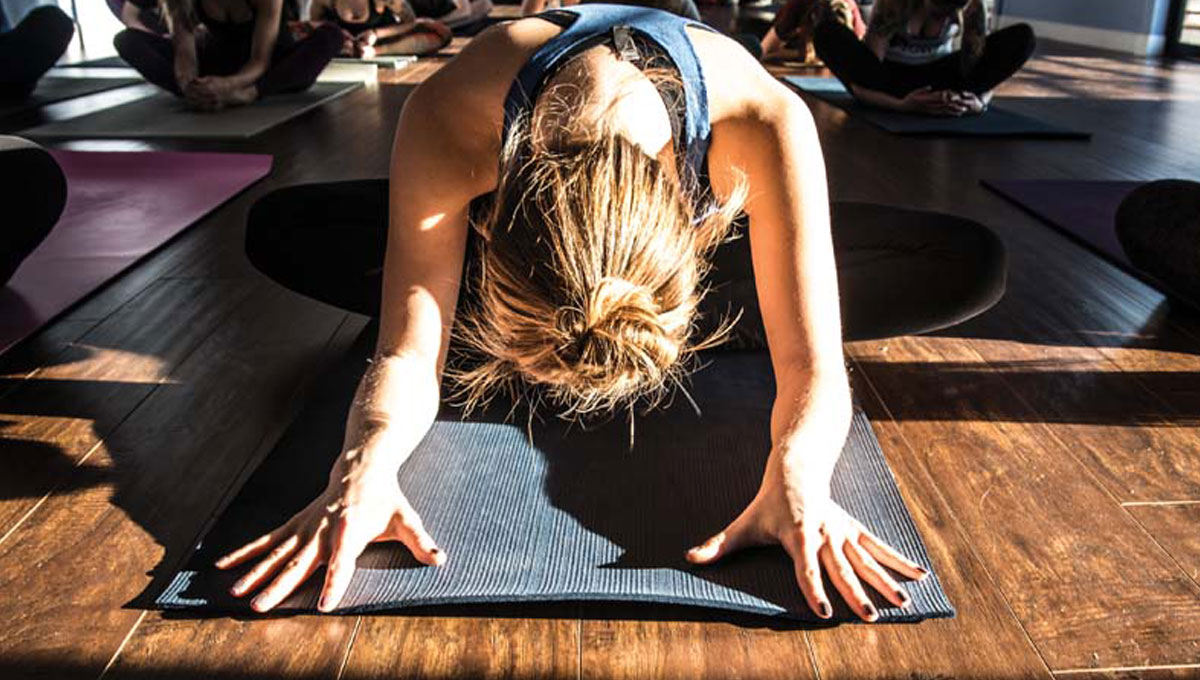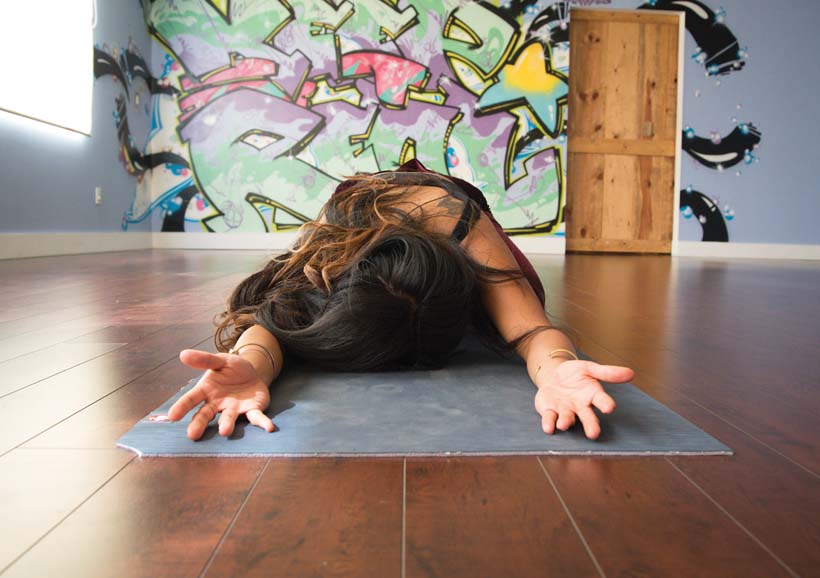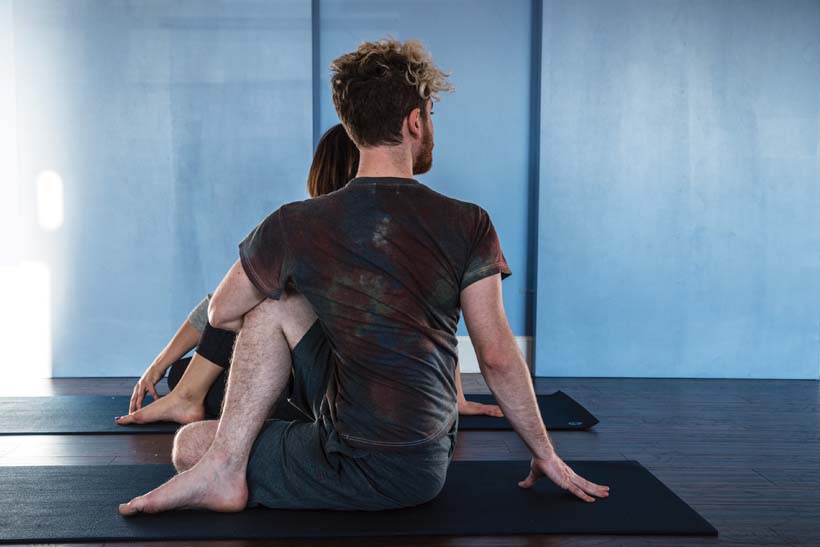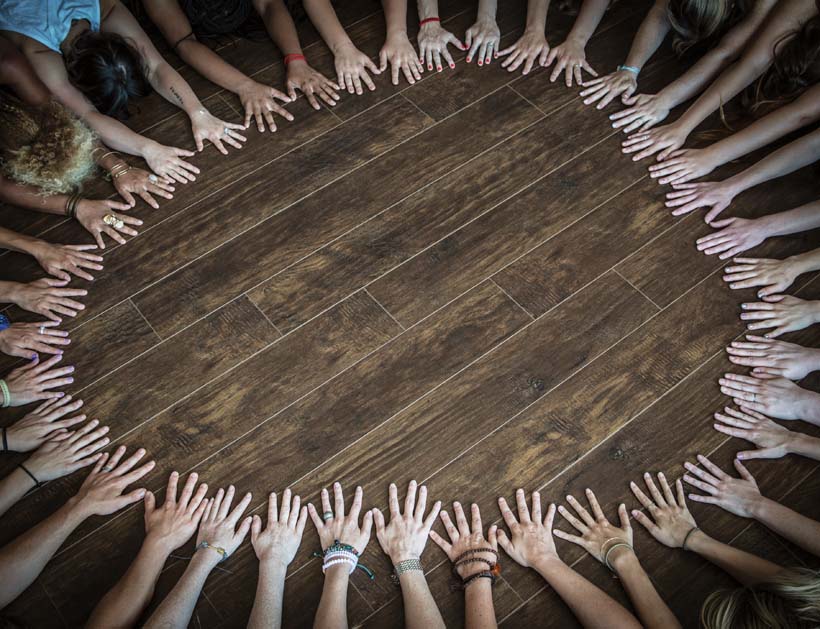
Inquire within when it is time to choose a teacher training program. Photo of the One Down Dog Community by Sarit Rogers (Sarit Photography)
Following the Call: Yoga Teacher Training
When I enrolled in my first yoga teacher training program, it was because my teacher was gathering a group of students for a nine month long course. While I was dedicated, I took classes, I practiced on my own, I took meditation intensives, I always wanted to learn more and deepen my practice. But I wasn’t quite sure I was ready. I wasn’t sure if that moment was the moment to start teaching. But to any obstacle I presented, my teacher offered a solution, whether it was adjusting my schedule, figuring out a payment plan, or convincing me that the sincere pursuit and participation in the course would help me become ready. It wound up being a life-changing experience for me and the start of many teacher training programs, retreats, intensives, and courses of continuing education in what has become a lifelong course of study.
My pursuit began more than 20 years ago. This was before there were programs measured by hours and curriculum, before disparate members of the teacher training community had come together to create Yoga Alliance and make an attempt to set internal standards, rather than having them imposed by external structures as the profession of yoga teaching grew.
That first class of 10 people had a grassroots feel to it. We met in the evenings in a multipurpose room at a gym and on the weekends at our teacher’s home. We would gather together in each other’s living rooms and review philosophy, anatomy, and practice teaching on each other. As part of our homework, we were required to record ourselves teaching mock classes and exchange the cassette tapes with each other so we could practice giving instructions that were so clear and precise that someone could follow us without the need for demonstrations. When I first began teaching classes to people beyond my group of fellow trainees, I was terrified, but through this new immersion I sensed a calling building, I felt the pull to share the practice.
The story I tell is much like other people’s journeys. It begins with an interest in learning more about yoga—the poses, the relationships in our body and mind, the philosophy. We find some part of ourselves on the mat or in the yoga studio, and we experience healing or a sense of wholeness in a new way. There is a pull to deepen one’s practice. We fall in love. All of it changes our lives. We look for a way to expand our knowledge, our practice, and our teaching chops. We may feel a pull to share. We want to give back.
How to Choose a Teacher Training Program
When we do feel the calling and decide to act on it, a situation like mine may come up (where a teacher we are already studying with is planning a training course we can take). If a ready solution does not offer itself, there are so many more options, opportunities, credentials, and lineages of different types of yoga to pursue. I’m often asked to answer the question, “How do I choose a teacher training program?” To answer, I ask more questions as well as offer some advice.
First, I think yoga teacher training ought to come with a warning label: Once you begin, you may never stop. Even more accurately: Once you begin, if you are serious about teaching, do not think about stopping. The truth is, while the profession of yoga teaching has matured to a place where there are hours, credentials, and requirements for continuing education. The art of learning to teach yoga—at its core—was always meant to be a lifelong course of study. In some lineages or traditions you would teach when your teacher signified that you were ready, and after that, you would continue to refine your own training, always coming back to study more and to continue to be mentored. Plan on some version of this once you commit to the vocation of teaching yoga.
Why Are You Taking Teacher Training?
When you ask yourself this question, know that every answer is a valid one. Each and every reason to clear your schedule, make the payment, and embark on a course of study is valid. Also know that you might have many reasons pulling you in this direction and that the reasons and rationale might even change over time. Remember, this is a life-changing decision and a life-long course of study. Two important steps you can take as you make this choice: Ask yourself a lot of questions and take the time to answer them as you do your research.

Photo of the One Down Dog Community by Sarit Rogers
First: Know Yourself
As you contemplate the options and make a series of decisions, take some time to know yourself and consider what really works for you. How do you learn best? Do you need to absorb and integrate material over a period of time or do you prefer to get it all right now? Do you want to stay home, or do you love to travel? Do you have that overseas retreat experience on your bucket list and feel like now is the time? Do you have family obligations that keep you at home? Do you have vacation time at work, or are you between gigs? Take some time and write a list of what works for you, what you are looking for, and even your dream scenario. With all the teacher training options out there, your ideal situation just may be available.
What it Means to Deepen Your Practice
Make a list of your goals. One of the common goals for embarking upon teacher training is the often-cited desire to deepen one’s own practice. This can mean different things to different people and can include (but not be limited to) the following.
- A more nuanced understanding of the practice.
- Overcoming yoga intimidation.
- Developing more control when it comes to the body, breath, and thoughts.
- An immersive experience in which we explore our interconnected relationship with our body, mind, heart, and spirit on the mat.
- Finally understanding some portion of what the teacher is saying when they cite the Sutras or give seemingly esoteric anatomical references.
- Pursuing specialty knowledge such as Ayurveda, Vipassana and other meditation techniques, or some other facet of practice and philosophy.
- Wanting to do a handstand in the middle of the room.
- Or seeking and cultivating a of community.
Allow any and all of these to influence your choice of program.

Photo of the One Down Dog Community by Sarit Rogers
You Know You Want to Teach
There is no doubt in your mind: Teaching is your jam. If you are enrolling in a teacher training program in order to become a teacher, think about where and what you want when you begin teaching. This is where some research will come in handy and a spreadsheet. Ask yourself if you have a dream teaching location, whether it is a particular studio or gym, your kids’ school, or a dream teaching population such as pregnant women, people in different age groups or with special needs, veterans, people who are incarcerated or athletes.
Look into the specialized training or certifications you might need to achieve these dreams. For example, some settings require that in order to teach there, you must go through their branded teacher training or mentoring program and you may need to clock some hours assisting your mentor or other teacher’s classes. You may need to turn in credentials proving specific numbers of hours to apply for a teaching slot in a particular location. You may need specific training for working in settings like schools or detention centers, and you may need to audition. Examine and make a list of the requirements. Look for a training program that prepares you adequately to pursue your calling.
Get Out Your Planner
One of the practical considerations of teacher training is to consider just how it will fit into your schedule while juggling work obligations and family life. The modern-day teacher training schedules take these types of concerns into account. Options for pursuing teacher training vary from semester-length courses during the day, evenings and/or weekends to, intensives of weeks or months, and modular systems that allow you to pace yourself with a program that is split into a number of discrete courses which you can take individually to add up to a complete program.
Intensives can be residential (at an ashram or retreat center, college or university, or a hotel or resort). Or you can choose a non-residential experience where you can remain at home but go to a studio or other location for an immersive deep dive into practice. Many programs offer a combination of yoga teacher training intensives and ongoing programs. Make the choice for what fits best into your life and what would fulfill your need for either transformation and/or pursuit of the practice.
Dollars and Cents
Consider your budget when comparison shopping. Explore payment plans, early registration discounts, and work exchange programs. Remember to factor in the need to purchase books or other supplies as well as additional classes or even mentoring time. Some programs held at studios may also include class packages or even unlimited yoga so you can experience the training. If you are choosing to travel, make sure to include the costs of transportation, car rentals, accommodations, meals, and other incidentals. Look at the fine print, the FAQs, the materials’ lists and any clothing guidelines and school policies. Schools have rules. Plan appropriately so that this experience releases stress as opposed to plunging you into debt.
Find Your Alignment
One of the reasons there has been a proliferation of so many styles of yoga is that we as individuals are drawn to different types of practice. We have affinities to styles of yoga. Some of these are lifelong commitments. Yet it is also important to recognize that this affinity can be fluid. We may notice changes over time. We may be attracted to a vigorous Ashtanga, power, or flow practices and then shift our focus to yin and restorative practices. Or we may find ourselves wanting all of them to round out a practice.
Feel into how aligned you are with a particular teacher training program by sitting in on classes, thoroughly reading the material, meeting with teachers, asking questions. Connect to your gut instincts that may not have a place on a spreadsheet or wish list. We often know at some level when a teacher or program is right for us. Trust this intuition.
Community
We often attend classes in a studio or other location because of the community created in that practice space. It may be a community that forms around a shared ethos or values, around a teacher or group of teachers, or something that arises among the people on the surrounding mats. Consider the importance of community when choosing a teacher training program. You’ll be spending a lot of time with your fellow teacher trainees and you’ll share intimate and vulnerable moments. Look for a sense of mutual support and a situation where people have each other’s backs and yet challenge and inspire one another.

Photo of the One Down Dog Community by Sarit Rogers
Continuing Education and Yoga Teacher Training
Let’s return to the part about teaching yoga being a lifelong pursuit. So this means, yes, continuing education. One 200-hour teacher training program is just the beginning. For that matter, a second teacher training or even the hours that lead up to a 500 hour program is not the end. You may want to seek out a program, studio, school, or tradition that provides opportunities for continuing education. You may also want to look for specialty programs or study with a variety of teachers to ensure you can absorb well-rounded perspectives into what is, in a reality, a vast practice. Don’t let this bog you down too much if you’re just getting started. Begin and know it is a journey that continues as long as you practice.
The Great Unknown
Recognize that no matter how much you plot, research, and plan, ultimately, actually being in a teacher training program is committing to the great unknown. You don’t really know what you will learn, how you will respond, and what will happen in each session on the mat during a course of study. Be prepared to have an open mind, a compassionate heart, a ready body, and a willing spirit.
Also understand that teacher training programs themselves are in a constant state of evolution and refinement. A program may also develop and morph while you are in it. Accept and embrace that there is something about teacher training that is also a co-creative experience and that you are an active participant in your own education and transformative experience. Remember too that the teacher learns from the students and we all learn from our peers. Yoga is a living tradition, an art and science that is in constant relationship with the here and now.
Living Yoga
Yoga is a historical philosophical system with a tradition and teachings based on texts written in Sanskrit and other languages over centuries. It is a tradition that is also passed on from student to teacher with knowledge not necessarily found in books, but found in the space of meditation, the attention of practice, and learning to cultivate the wisdom of the body. As mentioned, this is also a living tradition and the post-modern bodies we live in, the unique pressures of the time and society in which we live today, the whys that bring us to practice, and what practice means to us, all have a modern-day context.
Collectively, we’re all trying to figure it out. We’re all negotiating the frailties and challenges of our humanity with our idealized pursuit of a practice that embraces transcendence and allows us to experience ourselves more fully. It is important for all of us to have both compassion for ourselves and our larger community while challenging ourselves and cultivating honesty—with each other and within our practice.
Self-inquiry, while confrontational, is one of the ongoing practices that allow us to fulfill this. Journal, process, bring awareness to what disrupts your balance and what helps bring you back, explore and maintain your ongoing self-inquiry as you embrace this lifelong journey.
Yoga Teacher Training Thanks and Credits
Thank you to Andrea Marcum for her insightful conversations while working on this piece.
Sarit Rogers is a photographer, writer, and yoga teacher. She can be found at saritphotography.com
Felicia Tomasko has spent more of her life practicing Yoga and Ayurveda than not. She first became introduced to the teachings through the writings of the Transcendentalists, through meditation, and using asana to cross-train for her practice of cross-country running. Between beginning her commitment to Yoga and Ayurveda and today, she earned degrees in environmental biology and anthropology and nursing, and certifications in the practice and teaching of yoga, yoga therapy, and Ayurveda while working in fields including cognitive neuroscience and plant biochemistry. Her commitment to writing is at least as long as her commitment to yoga. Working on everything related to the written word from newspapers to magazines to websites to books, Felicia has been writing and editing professionally since college. In order to feel like a teenager again, Felicia has pulled out her running shoes for regular interval sessions throughout Southern California. Since the very first issue of LA YOGA, Felicia has been part of the team and the growth and development of the Bliss Network.
